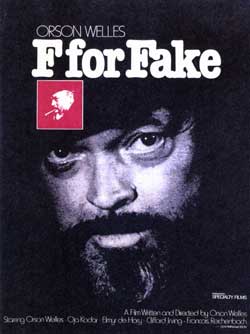 Every film that Orson Welles made was distinctively an Orson Welles movie. Even something like The Stranger, which was Welles’s one attempt to make a standard studio film, still ends up looking like an Orson Welles movie. Of all the films he made, however, there might not be a more “Wellesian” Welles picture than F for Fake.
Every film that Orson Welles made was distinctively an Orson Welles movie. Even something like The Stranger, which was Welles’s one attempt to make a standard studio film, still ends up looking like an Orson Welles movie. Of all the films he made, however, there might not be a more “Wellesian” Welles picture than F for Fake.
If we can say that there is no other drama quite like Citizen Kane, and no film noir quite like The Lady From Shanghai, and no Shakespeare film quite like Falstaff, then how do we even begin to address the uniqueness of F for Fake? Well, let’s begin with the fact that no one quite knows how to categorize it. Is it a documentary? Or is it better thought of, as some have suggested, as an “essay film?”
I prefer to call it a work of creative nonfiction. It blends together documentary footage, interviews, dramatic recreations, and almost Expressionistic performance art set-pieces for a meditation on art, forgery, and expertise. Welles starts by looking at the career of the world famous (or world infamous) art forger Elmyr de Hory, the subject of a book called Fake by Clifford Irving…who himself was shortly to become notorious as the author of a bogus autobiography of Howard Hughes. Welles follows this swirl of events and uses them to ponder several questions about the nature of art: What is the value of authorship? If no one knows the difference between a real masterpiece and a fake masterpiece, then is there a difference? Are critics and experts merely con men pretending to know what art “is” so that they can have a job teaching the rest of us? At one point in the film Clifford Irving admits, “I’ve lost my faith in the concept of expertise,” and, indeed, F for Fake functions as a takedown of the very idea of expert appreciation.
In a video introduction to the film recorded for the Criterion Collection, director and Welles scholar Peter Bogdanovich says that Welles saw F for Fake as his route back to commercial viability. If this is true, it neatly demonstrates how gloriously unattuned Welles was to the commercial marketplace. As writers like Jonathan Rosenbaum have pointed out elsewhere, F for Fake is, among other things, a critique of the commodification of the art world. Art experts, in this view, basically exist to tell rich people why they should value one piece of art above another — something which Welles clearly finds repellent.
This is all well-travelled ground in appreciations of this film, but something that has received less attention is the odd fact that F for Fake is also a meditation on Oja Kodar's perfectly sculpted ass. Welles's companion and collaborator during the last two decades of his life, Kodar features prominently in this film, mostly as a figure of erotic attention. I bring this up because a) the Oja fixation is something that is rarely written about in relation to F for Fake, and b) it is impossible to ignore that this often brilliant film has an entire subplot dedicated to her ass. The film begins with Welles secretly filming men as they ogle Oja as she walks down the street in a short skirt. The camera, it should be noted, ogles her, too. Is this simply Welles overindulging his fixation of Kodar? Is this his way of setting up the last act of the film, the story of Kodar's brief relationship with Picasso and her involvement in a forgery of his work? Is it both?
All of Orson Welles at 100:
![]()
I vote for both. One of the fascinating things about Welles’s work with Oja Kodar, both here and on unfinished projects like The Other Side of the Wind, is the way he uses her as a film object. He put all three of his wives onscreen at some point — Virginia Nicholson in Hearts of Age, Rita Hayworth in The Lady from Shanghai, and Paola Mori in Mr. Arkadin — but Oja Kodar is the only woman he ever really eroticized. (The Lady from Shanghai close-ups of Hayworth singing in a swimsuit were all studio mandates, an attempt to make the film less grotesque.) It should be noted here that Kodar was more than just a pretty face (and nice ass) in Welles’s films, she was his full artistic collaborator in way that, frankly, no one else ever was. The erotic nature of their work comes not just from him looking at her, but from her own interests in sex and power. She’s best thought of, in fact, as the co-author of this film. Among other things, she’s the one who gave Welles the story about Picasso, which becomes the unifying parable that closes out the film. So as much as the film is about art and expertise and fakery, it is also about the rather mystical screen presence of Oja Kodar.

While Kodar figures into the most playful sections of the film, the most poignant moments come in a haunting section in which Welles visits Chartres Cathedral in France. One of the most beautiful buildings in the world, the 12th Century masterpiece is an anonymous work, he tells us, yet its artistic and spiritual value is beyond question. Here we have Orson Welles, poster boy of the auteurist film critics, essentially repudiating the entire auteurist theory of art. It is one of the greatest moments Welles ever put onscreen, a summation of his thoughts on art, and on life itself:
Our works in stone, in paint, in print, are spared, some of them, for a few decades or a millennium or two, but everything must finally fall in war, or wear away into the ultimate and universal ash — the triumphs, the frauds, the treasures and the fakes. A fact of life: we're going to die. “Be of good heart,” cry the dead artists out of the living past. “Our songs will all be silenced, but what of it? Go on singing.” Maybe a man’s name doesn’t matter all that much.
Jake Hinkson is the author of several books, including the novel The Big Ugly, the newly-released short story collection The Deepening Shade, and the essay collection The Blind Alley: Exploring Film Noir's Forgotten Corners.
Read all of Jake Hinkson's posts for Criminal Element.

Postscript: Check out this fun dissection of some of Welles’s editing strategies for F FOR FAKE:
[url=https://www.youtube.com/watch?v=1GXv2C7vwX0&app=desktop] F FOR FAKE: How To Structure a Video Essay[/url]